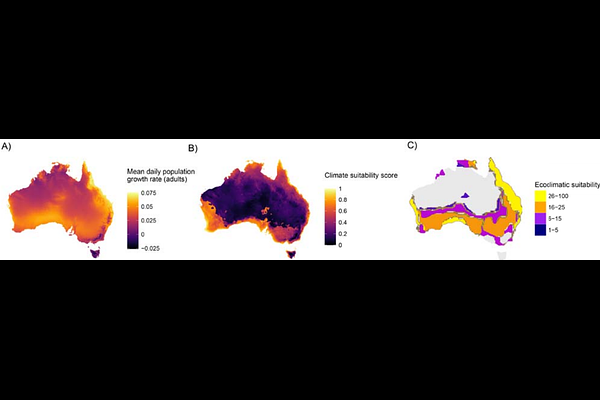Boring beetles and super models: mapping the distribution of a new invader

Boring beetles and super models: mapping the distribution of a new invader
Coates, A.; Phillips, B. L.
AbstractThe impact of an invasive species is strongly influenced by the extent of its invaded range. Predicting the potential distribution of an invader is thus critical for informing decisions around surveillance, containment, and eradication. Such predictions ideally would come from a mechanistic species distribution model. These models directly describe how aspects of the environment affect organismal fitness, and may also provide insight into population dynamics, such as rates of population growth and spread. Here, we develop a temperature-dependent stage-structured population dynamic model for a globally significant invader, the polyphagous shot-hole borer (PSHB, Euwallacea fornicatus). We use this model to predict the beetle\'s potential growth rate across its invaded range. Invasive PSHB causes serious damage to urban and agricultural trees, and so the continued expansion of its global distribution is a major concern. We synthesise previous studies to parameterise the model, yielding estimates of population growth as a function of daily temperatures within a host tree. We ran the model over one year using daily climate data across regions with invasive PSHB populations: South Africa, California, Israel and Australia. Our potential distribution maps indicate that PSHB currently occupies the most climatically suitable parts of California and Israel, but is yet to invade the most suitable regions in Australia and South Africa. The model shows the species is capable of very high population growth: in already-invaded locations, the average daily growth rate had an upper bound of ~ 0.05 (equivalent to population doubling in 14 days). Growth predictions were sensitive to the parameter for adult female mortality during between-host dispersal. This is an uncertain parameter (there is very little data available), but we estimated that for current populations to persist, the loss through dispersal mortality needs to be < 40%. We use our model to predict the maximum spread rate of PSHB (discounting transport by humans) to be 3 km/year. Our model provides insights into the spatial and temporal heterogeneity of invasion risk, which will assist global efforts to manage the ongoing invasion of this species.